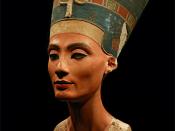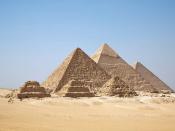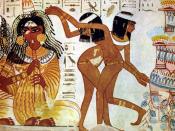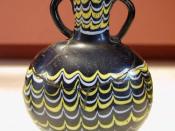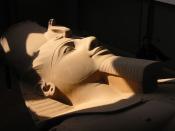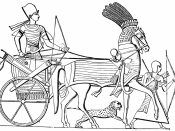Since the prehistoric age up until the present day, art has been used as a method of expression. Whether it is a mural that represents a massive hunt on cave wall or a multi-million dollar painting that looks like three red stripes, these are pieces of art in which humans have learned to express culture, religion, politics, emotion, and many other types of expressed actions and behavior. As humans evolved throughout time, so did their artwork. Laws and languages eventually developed and with that, art became a way of expressing life. Like any typical civilization, Egyptians had rules, religion, and traditions which they lived by, but art was not used so much to display typical everyday life. Instead, Egyptian art was very specific in its use - to portray the culture of royal Egyptians, or as in most art pieces, the portrayal of gods and events related to them. Ancient Egyptian art compared with modern day art differ a great deal.
There is a mass amount of change between ancient and modern day artists. A number of factors such as war, change of religion, and a stable growth in population influenced this change. This essay will discuss how the role of artists today compare and differ from those in ancient Egypt.
Today, modern society has a universal characteristic in mind about an image of one's own cultural experience. For example, we have an image of what a king should look like: He lives in a beautiful palace filled with gold and riches. He sits in a velvet red chair finished in gold and travels in a carriage pulled by beautiful horses and armored soldiers. Because Egyptian art was a self-perpetuating ideal, it established a proper form of expression: The image of royalty and gods. Like our image of a king, Egyptian artists were automatically absorbing these ideal types of images of gods and royalty into their skills. It was preferred that Egyptian artists work under these regulations -2- and so it was a combination of mental persuasion and natural skill that made Egyptian artists' work focused on images of gods and royalty. In the present day, artists have the freedom of working with a various amount of subject matter such as emotion, love, war, sex, religion, personal experiences, and any other type of occasion that involves some sort of cultural activity.
Additionally, Egyptian art was not based on what the artist could see at a given moment, but rather on what they knew belonged to a person or a scene. It was out of these forms which they had learned, and which they knew, that they built their representations, much as tribal or native artists build their figures out of the forms they can master. It was not only their knowledge of forms and shapes that the artist embodies in their picture, but also their knowledge of its significance. For instance, we sometimes call a man a "ÃÂbig boss'; the Egyptians drew the "ÃÂboss' larger than his servants or even his wife.
With this is mind, Egyptian art and style followed a very strict set of laws, which every artist had to learn from when they were very young. For example, Seated statues had to have their hands on their knees; men had to be painted with darker skin than women; the appearance of every Egyptian god was strictly laid down: Horus the sun god, had to be shown as a falcon or with a falcon's head. Anubis, the god of death, had to be shown as a jackal or with a jackal's head. Every artist also had to learn the art of script writing. They would have to carve and cut the images and symbols of the hieroglyphics clearly in the stone. As mentioned earlier, artists were bred to express art in this form. They did not want to do anything different because no one asked them to be "ÃÂoriginal'. Similarly, Egyptians valued beautiful items such as -3- sculptures of gods and painted works of royal gatherings and nature. Since this was the only type of art that Egyptian artists could practice, it was also the only type of art that was socially accepted in a system of high worship, tradition, and religion. It's true that that new fashions would appear, and new subjects were demanded of the artists, but their style of representing man, royalty, gods, and nature remained constant.
Indeed this style of art remained the same for many hundreds of years; however, a king called Amenophis IV, a ruler in the time period known as the Eighteenth Dynasty, broke the tradition. He did not wish to pay homage to many strangely shaped gods of his people. Instead, he worshiped one god, Aton, whom he had represented in the shape of a sun. A picture of him lifting his daughter on to his knees and walking through a garden hand in hand with his wife are a few examples on how Amenophis IV wished to use art with more freedom and realism. Another great example of his rebellious art was a painted piece of woodwork portraying his successor, Tutankhamen, as a more relaxed and realistic figure. He looked no larger than his wife and she gently rests her hand on his shoulder. (*Figure 3,17, p.102) He kept the same style of the old traditional art pieces, but used it in a way which he felt was more personal and enjoyable as compared to the traditional, law abiding techniques.
Finally, the answer of how the roles of artists today compare and differ from those in Ancient Egypt is more clearly understood. While traditions, laws, and cultures evolved over the centuries, so did art. Art is no longer restricted to a system of rules and regulations, but instead it has become a -4- hobby, a way of living, and countless other expressions and experiences of culture. Artists today have more freedom in expressing their work, however, Egyptian artists did not ever think that art was a freedom of expression. Art was a rule just as in modern day the age of eighteen is the legal age for filing income tax. Egyptian art was hardly ever used for personal enjoyment; it was used as a method for recording events "ÃÂ usually of royal nature. For example, western society raises their children to believe that wearing clothes is the proper way of going out into the public. Comparing that with South American children, nakedness is a natural part of their lifestyle. There are many other factors such as resources and climate that influence the use of clothing, but the main influence is tradition. Egyptians were a very traditional culture and artists, beginning at a very young age, would practice the demanding skills of carving in stone. This was the way of life for them, they knew no different nor would they even think of using art for something else other than the goal to represent something beautiful and majestic. It is true artists today have more freedom of art compared to ancient Egyptian artists, but as explained in this essay, there are many factors to why Egyptian artists did not have an alternative to their style and expression of art.
